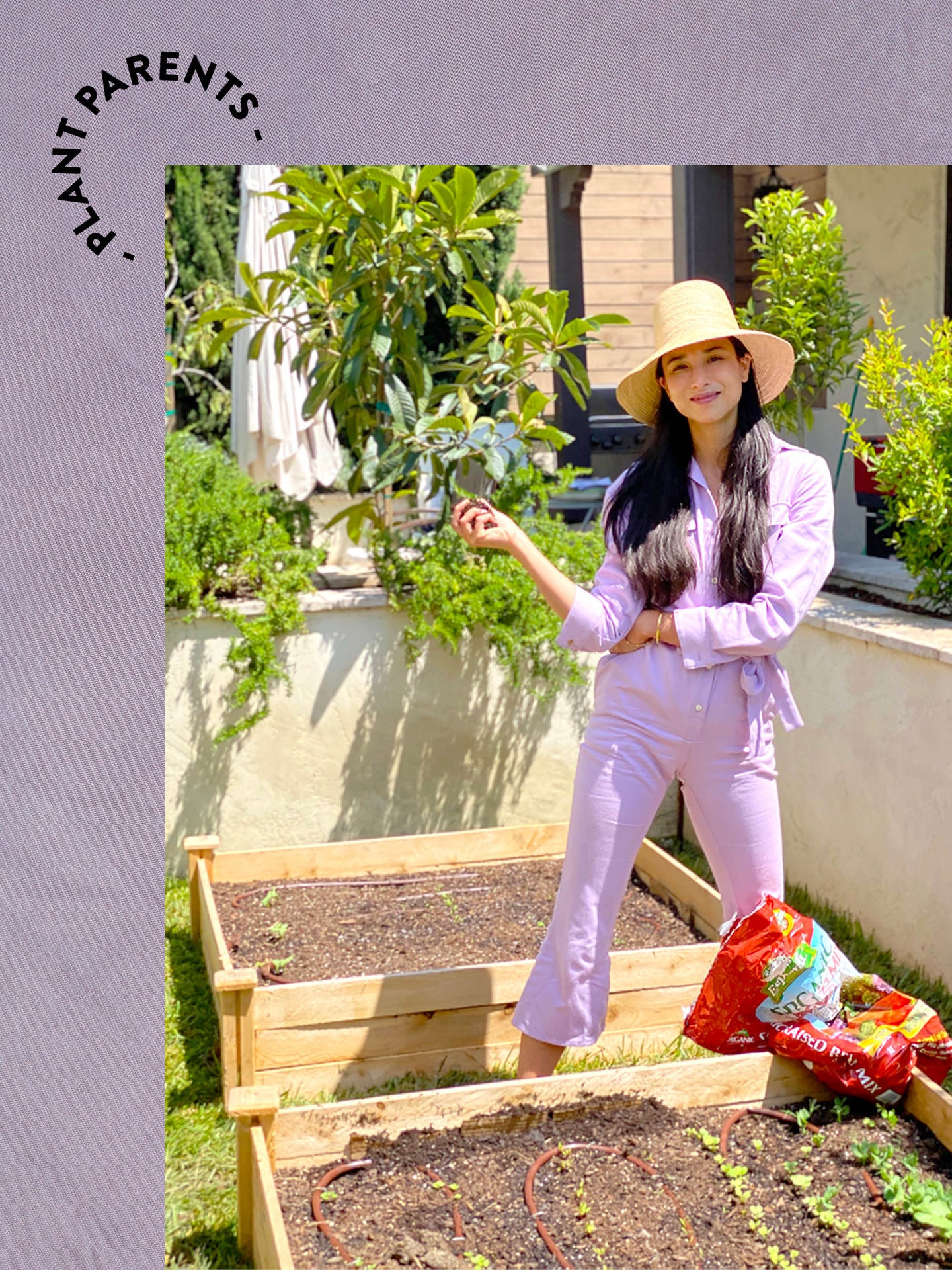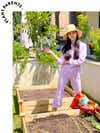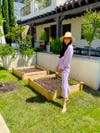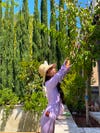Landscape Artist Lily Kwong Walks Us Through Her First Vegetable Garden
“Every morning feels like Christmas.”
Updated Oct 1, 2021 10:31 AM
We may earn revenue from the products available on this page and participate in affiliate programs.
Finding that corner with optimal sunlight, the perfect pot, and the trick for guiding a little sprout to its full, wild potential—is there anything more gratifying than helping a leafy, living thing thrive? In our new Plant Parents series, we spotlight flora lovers and their tips and tools for raising happy, healthy buds and blooms.
Lily Kwong was set to debut a major installation piece on Fifth Avenue shortly after New York City had shut down due to the COVID-19 pandemic. She had just flown out to Los Angeles, where her boyfriend lives, and planned to return in May, but now finds herself, at least temporarily, uprooted. So she’s decided to put down different kinds of roots.
As a landscape artist, Kwong typically creates massive, lush, plant-filled installations—she’s the mind behind the small mossy mountains that filled Glossier’s recent Seattle pop-up and a floral canopy that covered a fourth-mile stretch of Manhattan’s High Line in 2018. But save for the work she did in her California backyard growing up, she had never really tended to a garden of her own. And now, she reasoned, was a time when more people than ever could really use a garden.
“Now my biggest project is two 4-by-4 raised beds in the backyard,” says Kwong. She’s not doing it alone either. Her new initiative, Freedom Gardens, is her studio’s call to action in response to the pandemic. Drawing inspiration from the victory gardens of World War II, the project started on Instagram in early May and will continue to expand with resources, lessons, and community posts that aim to give people the tools to grow their own fruits and vegetables in a time of food insecurity and job instability.
Freedom Gardens has launched with an initial focus on digital education, tapping experts like Shannon Lai, the farm manager at Brooklyn Grange Rooftop Farms, to share their knowledge specifically on working with edible plants. Later down the line, Kwong hopes to expand her efforts into opening community gardens and connecting with both policy-makers and clients in the private sector to push for widespread support for these kinds of resources. “I don’t want people to just look at beautiful photos,” she says. “I want people to reconnect with the soil.”
She aims to use her platform to share the work that organizations like No Kid Hungry and Edible Schoolyard have long been doing to fight food insecurity, and notes that she will, most likely, eventually return to her core artistic projects—building flower mountains in Grand Central Terminal and the like—but her current priority is all about addressing a need she sees in society. So Kwong finds herself in relatively new territory; a growing period that she deems necessary and exciting. Here, she shares the experience of starting her own freedom garden from scratch and her best plant wisdom.
On Growing Up With Plants
I have gotten as much of a thrill seeing my bean sprouts pop out of the soil as I’ve gotten from unveiling major public art pieces. There’s something profoundly beautiful, and it ignites this childlike curiosity in me—it triggers all these deep memories of being in the garden with my family. When my grandfather first came to this country from China, he worked on farms. He eventually became a banker, but part of my chores growing up was to go to the farmers’ market with him and help him in the garden.
On Practicing Patience
People want things to look beautiful immediately. For my large-scale work, we’d get huge trees, open flowers, and clip away anything that was even a little bit brown. But that’s not true to the process of nature. Nature is slow and it unfurls and it’s connected to the larger ecology. You can get swept up in the momentum, and I feel like I’d forgotten a bit of what my purpose and values are. This is helping me reconnect with that idea in the smallest, gentlest, and slowest way. Every morning feels like Christmas—I pop out of bed, run down, and see what the little shifts are.
On Getting Started
To be honest, my raised beds and seeds sat in the backyard for two weeks before I set them up and planted anything. In spite of the big scale and budgets and timelines I’ve worked with before, I was more intimidated by these 4-by-4 beds.
I got kits for the beds because I wanted to put them together quickly—there are a lot of great ones online. I assembled them in half an hour. Shannon [Lai] mapped out my plot plan. I have tomatoes, parsley, basil, cilantro, dill, peppers, cucumbers, cabbage, kale, beets, carrots, and radishes.
On Educating Herself
I did an interview with Ron Finely, the Gangsta Gardener, who has a MasterClass on edible growing I found really helpful. I’ve taken a few New York Botanical Garden courses, as well as one with Annie Novak of Growing Chefs.
On the Biggest Piece of Growing Advice She Learned
What everyone says about growing veggies is that your soil is gold. You want to make sure there are healthy microbes in it, as well as nutrients. That’s the thing I love about plants—they’re so rife with metaphor. You need to have a good foundation.
On Finding a New Connection With Food
I kept worrying: What if a raccoon comes, or a storm, or a pest? I couldn’t imagine putting all this love and effort and care into something and having it totally wiped out. It made me realize people who grow food on an organic farm scale do it because they truly love it—it is such a complex, difficult endeavor. When I had the little seeds in my hands, I felt so disconnected from them—I almost couldn’t believe a plant could come out of something the size of a grain. But they have. It’s renewed this feeling of being on an extraordinary planet. Plants take water and sunlight and turn it into food and give it away for free. It’s a relationship you don’t get from going to Whole Foods and buying a cucumber.
On Her Best Plant Wisdom
My mentor always says, “Right plant, right place.” You want to check that a plant has the right exposure, whether that’s full sun, partial sun, or full shade. With houseplants, you want to be careful with watering. Since they’re in a pot, it’s easy for their roots to rot if you overwater them. Don’t let them dry out, but if you stick a finger in the dirt and it comes out even a little wet, don’t water it. And don’t let it sit in a saucer of water—it will just suck it all out.
I notice a real correlation between the health of my houseplants and my personal health when I’m not drinking enough water, getting enough sleep, or feeding myself properly. When you’re taking the time to do things a little more meditatively, and treat plant care more like a spiritual practice than a chore, that’s very helpful. Plants are a lot more like you than you think.
It’s hammer time: Follow @reno_notebook for easy rental updates, clever DIYs, and tips to nail your next project.




